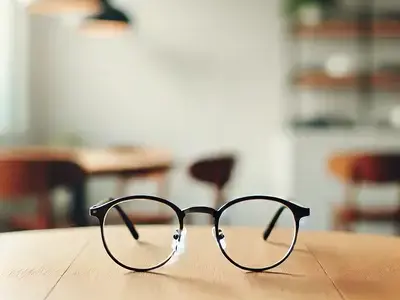It seems harmless enough—wearing your old glasses or maybe those hand-me-down readers for a while. But what actually happens when you wear the wrong prescription for your eyes? Turns out, it can affect a lot more than just your vision. Let’s explore the impact, break down the science, and get a sense of what you can do if you’re dealing with the wrong lenses.
What Happens When You Wear the Wrong Prescription?

Wearing the wrong prescription is more common than you might think. A 2023 survey conducted by the Vision Council found that approximately 30% of individuals are wearing glasses that do not properly match their current prescription. This issue isn’t limited to those who skip regular eye exams; even those who get regular check-ups may inadvertently end up with incorrect lenses due to errors in measurements or miscommunication with optometrists.
So, what exactly are the effects of wearing the wrong prescription? The symptoms vary depending on the severity of the discrepancy:
- Headaches: One of the most common symptoms, headaches often result from eyestrain, as your eyes work extra hard to compensate for a poor prescription.
- Blurred Vision: This is especially true if the prescription is either too strong or too weak. Everything becomes a struggle to focus, making your world a blur.
- Eye Strain and Fatigue: Incorrect lenses force the muscles in your eyes to adjust more than they should. This added stress can leave your eyes feeling tired and strained.
- Nausea and Dizziness: Wearing the wrong prescription, particularly with astigmatism, can disrupt spatial perception, leading to a sense of disorientation or even vertigo.
The Long-Term Effects: Not Just Annoying—Potentially Damaging
Wearing an incorrect prescription over long periods doesn’t just lead to discomfort; it can have consequences that extend well into your daily activities and health. According to Dr. Jennifer Patel, an optometrist based in New York, prolonged use of an incorrect prescription may lead to worsening visual acuity over time. She explains, “The brain adapts to what the eyes are seeing. If the eyes are constantly sending unclear or incorrect information, it may eventually impair the brain’s ability to process images clearly.”
Another concern is that children, whose eyes are still developing, may be particularly vulnerable. A 2022 study published in the Journal of Pediatric Ophthalmology found that children wearing incorrect prescriptions for over a year showed a measurable delay in visual-motor skill development compared to peers with correct lenses.
In adults, chronic eyestrain can lead to reduced productivity at work. For those who rely on their eyesight for detailed tasks—think graphic designers, surgeons, or drivers—an incorrect prescription could mean more than just frustration; it could mean mistakes that affect livelihoods.
Statistics to See Clearly: Who’s at Risk?
The following table summarizes the prevalence of incorrect prescriptions among different age groups based on recent findings:
| Age Group | Percentage Wearing Incorrect Prescription |
|---|---|
| Children (6-12 years) | 18% |
| Teenagers (13-19 years) | 22% |
| Adults (20-39 years) | 28% |
| Adults (40-59 years) | 35% |
| Seniors (60+ years) | 40% |
Why such high numbers? Several factors are at play. Children may have undiagnosed issues because they aren’t always good at describing their symptoms. Adults, on the other hand, may delay their eye exams due to time constraints or cost. Seniors may be dealing with changes in vision that happen quickly, making older prescriptions obsolete faster than expected.
Emerging Trends: Blue Light and Screen Time Complicating the Issue
Another trend affecting prescriptions is the increase in screen time. With more people working from home and spending extended hours in front of computers, phones, and tablets, the demand for specialized lenses—like blue light blockers or computer glasses—has surged. Wearing the wrong kind of prescription while using screens can aggravate symptoms of digital eye strain.
According to VisionWatch’s 2023 Digital Eye Strain Report, 65% of people working more than 6 hours per day in front of a screen reported experiencing symptoms of eye strain, with nearly half attributing it to using outdated or incorrect prescriptions.
Dr. Samuel Grant, an optometrist specializing in digital eye health, says, “People think blue light lenses are a catch-all solution, but if they’re the wrong prescription, or if they don’t account for your astigmatism, they could end up causing more harm than good.” He emphasizes the importance of having a prescription that’s tailored specifically for screen work.
Making It Right: What To Do If You Suspect Your Prescription is Wrong
If you suspect that your current prescription isn’t right, don’t delay. Here are some actionable steps to take:
- Schedule an Eye Exam: Get a comprehensive eye exam from a trusted optometrist. An annual check-up can help detect discrepancies early.
- Double-Check Your Glasses: Errors do happen during lens manufacturing. Take your glasses back to the optometrist for a double-check. A tool called a lensometer can confirm whether the lenses match your prescription.
- Communicate Clearly: If something feels off, communicate your symptoms in detail. Whether it’s headaches or blurred vision, sharing specifics can help your optometrist make the right adjustments.
Cost Considerations: Replacing lenses can be costly, but wearing the wrong prescription may end up costing even more in the long run—think missed workdays, reduced quality of life, and added medical expenses due to eye strain.
Editor’s Advice: Take Your Eye Health Seriously
Your eyes are more than just windows to the world—they’re central to how you experience life. Wearing the wrong prescription, even for a short period, can lead to discomfort and long-term issues that aren’t worth the risk. Be proactive: stay up-to-date with your eye exams, ensure your lenses are correct, and never underestimate the importance of wearing the right prescription. Remember, investing in your eye health now can save you from unnecessary strain and complications down the road. Take care of your eyes, and they will take care of you.





